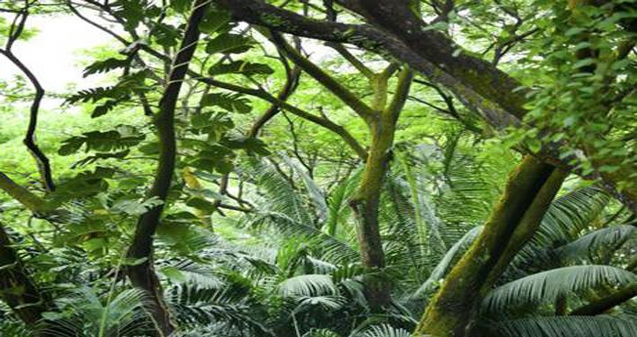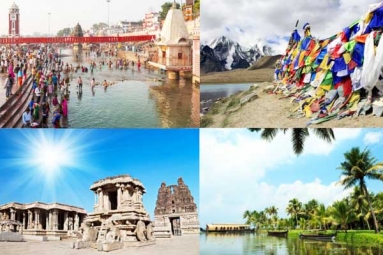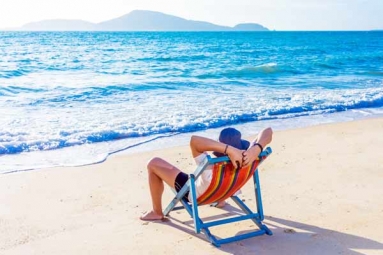
My driver drops down a gear to kick-start our car. There’s nothing wrong with it; it’s just a ritual we have to go through to negotiate the steep roads of Saint Lucia. This Caribbean island may be only 27 miles long by 14 miles wide, but its mountainous terrain (reaching its peak at Mount Gimie at 3,120ft) threw down the gauntlet to the road-builders, who cut as best they could into its volcanic mass. The result is a corkscrew of highways that will take you where you want to go – eventually.
That’s OK. I’m in no hurry and anyhow I’m distracted at each switchback by the dense jungle, steaming in the humidity. Occasionally, we emerge in a community of squat multicoloured houses with corrugated iron roofs, where balustraded porches provide a shady place for homeowners to escape the burning sun. Then it’s back into the foliage, the ocean flashing a blue smile between the trees.
Saint Lucia has sugar-fine sands worthy of lounging on for your whole stay, golden in the northern holiday playgrounds of Gros Islet, and Rodney and Marigot bays, and silvery in the south around the iconic volcanic spires, the Pitons, where the island’s top-end hotels cluster. But the interior is equally magnetic – a tangle of tropical forest filled with possibilities for active fun, from hiking to the island’s tropical heart on the Edmund Rainforest Trail (001 758 457 1427), to ziplining at the Treetop Adventure Park (001 758 458 0908), and slathering your body with restorative mud at the Sulphur Springs Park (001 758 459 7686).
There are cultural diversions, too. The spring Jazz Festival and summer Carnival (see “Beat Surrender” panel), and poetry lovers can take a turn around Derek Walcott Square, one of the few places of architectural note in the capital Castries, which honours the poet and Nobel Laureate who set his epic poem Omeros around Gros Islet. The island’s history is neatly told at Pigeon Island (see “Time Travel” panel), and, for a taste of life today, communities such as the fishing town of Soufrière, the old French capital, come alive during market hours. Pretty Anse La Raye is the place to spend Friday night for the Fish Fry.
For a radical alternative to lying on the beach, visit Saint Lucia’s newest attraction, Our Planet (001 758 453 0107; US$20/£12.50), which opened in Castries in June. The multimillion-pound centre, a partnership with Noaa and Nasa, invites visitors to explore Saint Lucia specifically and Earth in general to gain a greater understanding of the man-made and natural challenges facing our environment. As well as sampling views of the our planet from space, visitors can play games where they create hurricanes and power cities, and feel the effects of extreme weather in a special-effects theatre. All profits from ticket sales are used to fund environmental projects on the island.
Tourism has been one of the main sources of income for Saint Lucia for 30 years, but now the island is going upmarket, hoping to poach high-rolling holidaymakers from Barbados and beyond to the luxury hotels that have popped up during the past decade, notably Jade Mountain, Boucan and the transformed Jalousie Plantation, this month reborn as Sugar Beach, a Viceroy Hotel. Catering for increasing demand from premier passengers, British Airways, which operates daily flights to Saint Lucia, added first-class cabins to the 777s flying into the island last summer. This winter, Virgin Atlantic is adding 14 seats to its Upper Class and increasing its flights to five a week.
However, if First Class isn’t quite your stamp, avoid the school holidays and December to mid-April, when you’ll get far less for your Eastern Caribbean dollar. Though still hurricane season, November may be hot and humid but is a cheaper choice, and late April to June is usually blessed by good weather and has similarly lower prices. Tour operators include BA Holidays (0844 493 0758;), Virgin Holidays (0844 557 3865;), Kuoni (01306 747008;), and specialists Tropic Breeze (01752 880880;), Caribtours (020-7751 0660;) and Simply St Lucia (01732 811043;).
The only way is up
Saint Lucia has plenty of opportunities to get active in the wild, but the most seductive challenge is its twin volcanic pyramids, Gros and Petit Piton, which stand sentinel on the south-west coast at 2,619ft and 2,461ft respectively. It is the smaller Piton that presents the more arduous climb, but either one would offer a tough step class mixed with scrambling around tree roots and boulders. Local guides from the Interpretive Centre at Fond Gens Libra (001 758 459 3965;) will lead the way up Gros Piton for US$30pp (£19), a round trip that takes about four hours. There is no official guiding for Petit Piton, due to its perceived dangers.
Time travel
Pigeon Island (US$5/£3), off the north-west coast, may be only 44 acres but it has had a huge role in Saint Lucia’s history. This is where the Arawak lived until the Caribs kicked them out in AD1000. When the British took Saint Lucia from the French in the 1778, Admiral George Rodney fortified Pigeon Island for use as a vantage point to watch the French fleet. The island, now a national landmark, is looked after by the Saint Lucia National Trust. Visitors today can walk across the causeway from Gros Islet to explore its fortifications, learn about its 18th-century history at the Interpretation Centre in the restored Officers’ Mess, and take in the views of Martinique.
Beat surrender
Like the rest of the Caribbean, Saint Lucia loves the Carnival period, held in summer, from 26 June to 16 August in 2013. There’s a packed programme, including steel band, calypso and soca championships, and colourful parades and street parties that originate from plantation times, such as the J’Ouvert, when slaves danced about in costume with painted faces, mimicking and ridiculing the white settlers’ masquerade balls. The island also hosts one of the Caribbean’s top music events, the Saint Lucia Jazz Festival (001 758 452 4094; various prices) from 5-12 May. The brief has widened over the past 22 years from just jazz to include more mainstream music – international stars such as Diana Ross, Hugh Masekela and the late Amy Winehouse have all played here in the past – and performances now take place across the country, from Pigeon Island to Vieux Fort Square.
Just go below
Parrot fish, octopus, turtles and brain coral can all be seen off Saint Lucia, and Snuba, a hybrid of snorkelling and scuba diving, is a novel way to see them. You use a regulator and an air supply that floats on the surface. Training is quick; adults and children can do it, and no formal qualifications are needed. Cox and Company (001 758 285 7354;) has a half-day Snuba Marine Park Tour from Pigeon Island to Anse Cochon Bay, for $75 (£47), led by expert instructors.
Where to stay
There is a variety of accommodation, from guesthouses and flats to villas and beach resorts. The tourist board’s website, stlucia.org, offers comprehensive listings. But this season’s big story is the £100m transformation of the Jalousie Plantation to Sugar Beach, a Viceroy Resort (001 758 456 8000; doubles US$450/ £281). Among the many changes at the luxury 78-room hotel, which sits in the lap of the Pitons, are hillside villas and bungalows on the sands. In the hills above, Hotel Chocolat’s Boucan (0844 544 1272; doubles US$350/ £219), pictured, run by the British-based chocolatier at its Rabot Estate, has added eight stylish new lodges and the Cocoa Juvenate Spa. Other news includes the reopening of blu (01268 242463; doubles US$344/£215) at Rodney Bay.
Travel Essentials
Getting there and getting around
Kate Simon was a guest of BA (0844 493 0758;), and Sugar Beach, a Viceroy Resort (sugar). BA has a week next March from £1,869pp for bookings made before 19 December, based on two sharing, including B&B and flights from Gatwick. Virgin Atlantic (0844 209 2770;) also flies from Gatwick. From Hewanorra airport in the south of the island, if your hotel doesn’t include a transfer, you’ll need a taxi – which costs about US$100 (£63) to the far northern resorts. Public minibuses are cheap and run around the island’s main roads – just stick your arm out to hail one. For car hire try Avis (001 758 452 2700;) or Cool Breeze (001 758 459 7729;); daily rates from about US$84 (£53). You’ll also need a driving permit, price US$27 (£17).

















